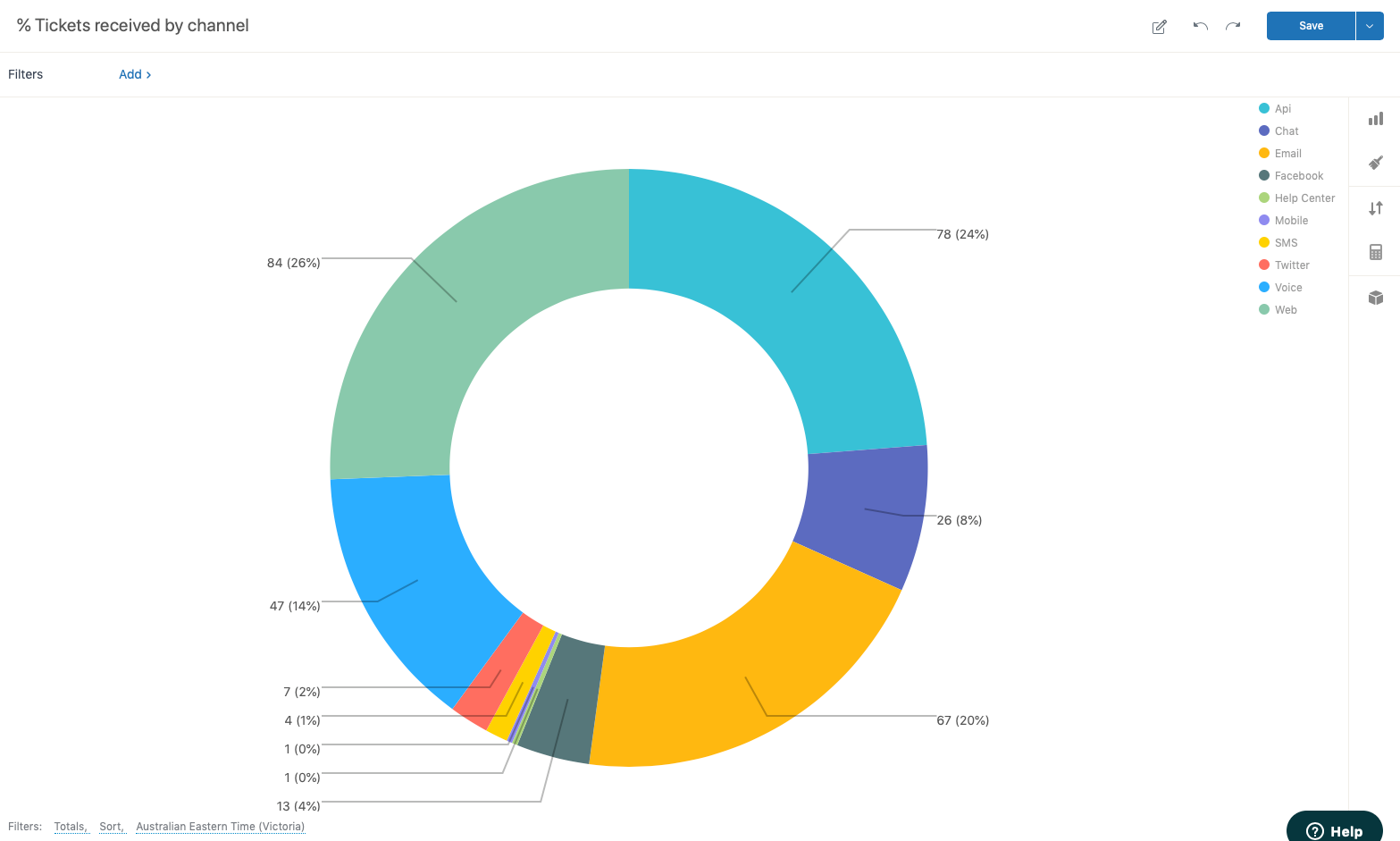Article • 7 min read
Customer service reports every business needs
Customer service reports help demystify important data. Find out how key metrics can track performance, provide valuable insights, and spot areas to improve.
By Leighton Jacobs
Last updated September 19, 2023
Zendesk’s CX Trends 2023 Report found that 40 per cent of business leaders now view customer support as a revenue driver. This growing number highlights the importance of first-class customer service to business success.
Frighteningly, 73 per cent of customers will switch to a competitor after multiple bad experiences. And staying on top of your customer service is easier said than done, especially with so many data points, stats, and KPIs to try to decipher—let alone draw insights from.
But that’s where customer service reports come in. They can help you make sense of the madness. Each report is built on one or more key metrics that help you better understand how your support team is performing. Let’s dive right in and find out how.
Ticket metrics

From total ticket volumes to customers’ preferred channels, the requests you receive hold a wealth of data just waiting to be leveraged. Here are the main ticket metrics to consider.
Total requests received
When you know exactly how many tickets are coming in over any given period, you can ensure you have exactly the right number of staff on hand—or consider a chatbot to reduce ticket volume. Tracking ticket numbers can also help you spot product issues. For instance, a big jump in tickets after a new product release is a sure sign something isn’t quite right.
Ticket open rate
Your open rate reveals what percentage of tickets are unresolved. After all, tickets might be coming in but resolving them is what matters. Tracking this metric can help you recognise when your team is falling behind allowing you to act quickly to ensure SLAs are met.
Ticket escalation rate
Some issues inevitably prove more complex and need extra input, e.g. from tech support. But if too many tickets are being escalated or even reopened, it might be a sign your agents need retraining or extra help to handle customer requests, e.g. an internal knowledge base.
Ticket channels
Zendesk’s CX Trends 2023 Report revealed that 64 per cent of customers will spend more when issues get resolved where they already are. So, it’s essential you understand how your customers are getting in touch—and this customer service report metric can help you do exactly that.
Top tip: omnichannel reporting can help you prevent data silos for a full view of customer behaviour and interactions across channels.
Ticket topics
Looking at tickets by topic can help highlight potential areas for improvement in your products or services. What’s more, it’s also a great way to assess how your self-service offerings are performing. For example, if customers keep getting in touch about topics covered in your knowledge base, it might be time to revisit those articles.
Ticket locations
According to the Harvard Business Review, around 56 per cent of customers rate access to information in their own language as more important than price. That’s a big deal but don’t forget about the importance of cultural differences too, which can have a major impact on customer service best practices. Looking at where your tickets are coming from can therefore help you better understand how to tailor your services for all your customers.
Agent performance

Agents are the lifeblood of customer support because it’s ultimately great people that make great customer service possible. Let’s see how you can track agent performance in your customer service reports.
Requests resolved
Measuring how many tickets each agent is solving helps you better understand agent productivity. Tracking this metric over time can help you spot trends and address any issues, e.g. if an agent is consistently solving a lot more tickets than the rest of your team, they might be cherry-picking easier issues. Or if an agent is getting through far fewer tickets, they might be struggling and need some extra training.
Average handle time
Put simply, average handle time is the amount of time an agent spends working on each support interaction. It’s the perfect metric to shed light on how much effort each agent is putting into their tickets. If this metric is going up, it means your agents are becoming less efficient and training may be required.
Top tip: avoid focusing on average handle time too much, as it can cause agents to prioritise speed over quality—a big no-no.
Customer satisfaction
Customer satisfaction (CSAT) measures customer satisfaction levels by collecting customer feedback after customer enquiries have been resolved—usually in the form of a short survey. Tracking this metric in your customer service reports is a great way to reveal where agents can improve and recognise high achievers.
Team performance

When it comes to customer service, it’s all about the team. Nobody can resolve every ticket on their own. Keep in mind though that many of these metrics can also be used for individual agent performance and vice versa.
First reply time
According to HubSpot, 90 per cent of customers rate an immediate response from customer service as very important. First reply time (FTR) is therefore an essential customer service report metric. Sometimes also called time to first response or average response time, it’s a key indicator of customer satisfaction, as shown by Zendesk research. If your first reply time is too long, it could be a sign of efficiency problems, e.g. tickets not being assigned correctly.
Top tip: customer expectations for FTR vary from channel to channel, so it’s a good idea to look at this metric by channel.
Time to resolution
This is a key resolution effort metric and is very similar to average handle time. In short, it measures how much time is needed to fully resolve support requests. Customers not only want a fast response, but they also want to get their issues resolved quickly. It’s no use replying quickly without properly solving the problem. This will just cause customers to keep coming back—pushing up resolution times and hurting the customer experience.
Customer wait time
Often referred to as requester wait time, this metric is the total amount of time customers spend waiting for responses and answers to resolve their issues. Great customer service is all about communication, so you need to keep the time customers spend waiting to a minimum—and time spent interacting to a maximum.
First contact resolution
First contact resolution (FCR) indicates how many tickets have been resolved with a single interaction. That’s no mean feat, especially when customers may have multiple pain points and follow-up questions. But the quicker the resolutions, the happier your customers. Again, this is crucial to customer satisfaction and a key metric for customer service reports.
Top tip: a high percentage of FCR tickets might indicate that many of your tickets would be better suited to self-service.
Interactions per ticket
The number of interactions it takes to resolve each request is an important customer service metric because it reveals how hard your agents are working to resolve tickets. The number of agent touches can provide real insight into customer service performance and even working styles between agents. Customers don’t typically like exchanging messages with multiple agents over multiple days. So, if this metric is particularly high, it could be a bad omen for your CSAT, and you may want to consider streamlining your support workflows.
These are by no means the only metrics for customer service reports and you can look at many more including, net promoter score (NPS), customer contact rate, and next issue avoidance. But we’ve covered some of the most important. And remember: whilst averages alone don’t always tell the full story, trends over time certainly do.
Comprehensive reports
Although each metric can be a report on its own, you can also mix and match metrics to create more comprehensive customer service reports. Here are three quick examples but the possibilities are truly endless.
Customer service team report:
Average response time
First contact resolution
Number of requests
Top-performing agents
Ticket-level report:
Ticket volume
Time to resolution
Open rate
Escalation rate
Individual agent productivity report:
Ticket volume per agent
Tickets closed
Customer satisfaction
Time to resolution
You can ultimately create countless reports focusing on different areas, including channel reports, time-tracking reports, and agent-ranking reports. It’s often only a question of what your customer service software will allow.
Zendesk reporting for duty
Zendesk gives you the flexibility to build the reports you need. Powerful analytics and reporting tools mean you have everything you need to create insightful and engaging customer service reports.
Get started right away tracking the metrics that matter to you and find your reporting happy with Zendesk.
